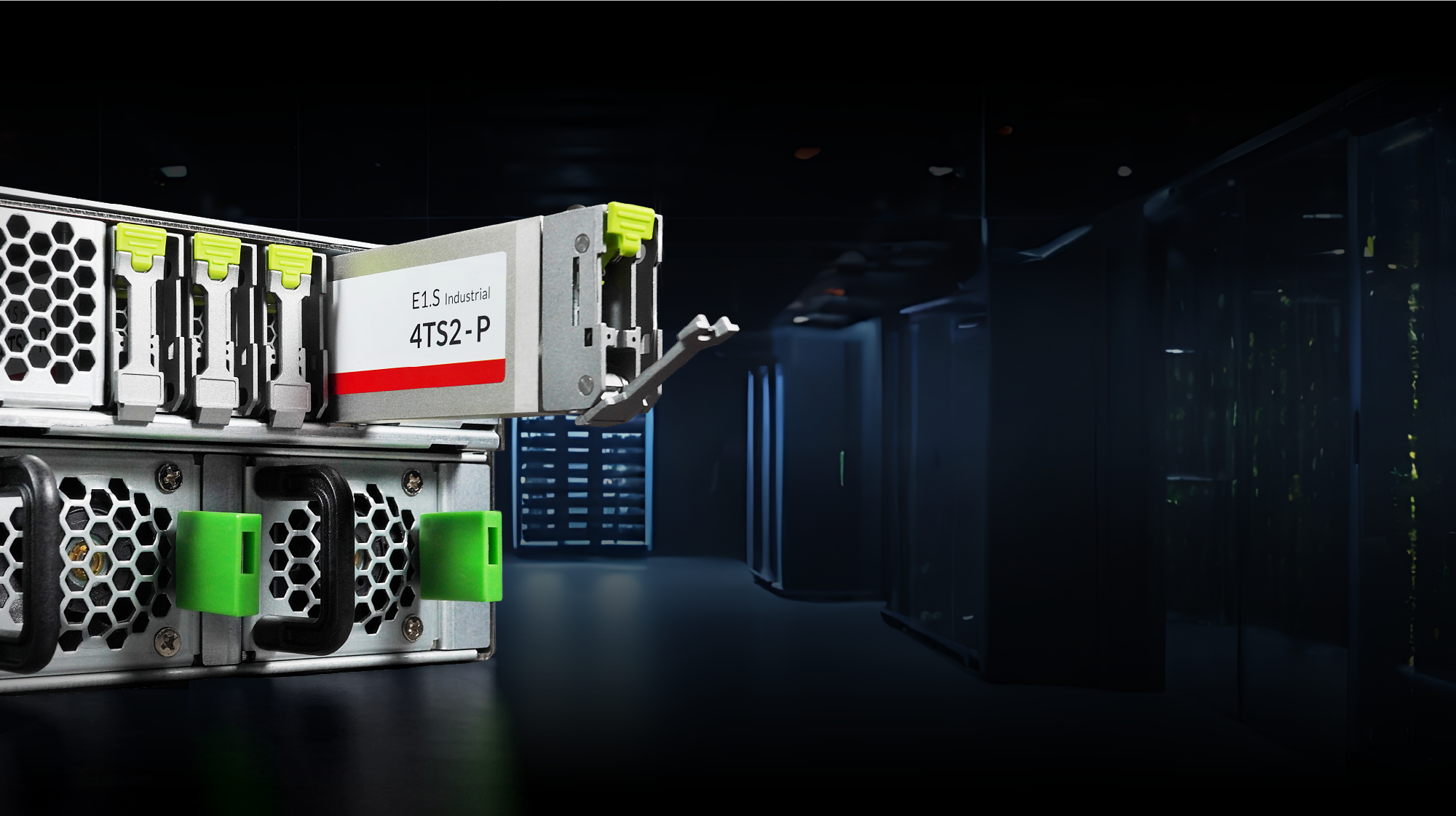Efficiency in Every Inch: Exploring the Space-Saving Benefits of DDR5 RDIMM VLP

As the demand for high-performance computing solutions and the complexity of data-driven applications continue to grow, the challenges of space-constrained scenarios become more noticeable. That’s where the DDR5 RDIMM VLP comes in. Join us on a journey through the world of DDR5 RDIMM VLP, exploring its technical hurdles to its advantages.
Typical Uses of DDR5 RDIMM VLP
DDR5 RDIMM VLP modules are widely used in a variety of computing environments, especially in space-constrained server configurations. By minimizing the physical footprint of the PCB, these modules can maximize the utilization of available space without compromising performance or reliability. Whether deployed in compact blade servers or other form factors where space is precious, DDR5 RDIMM VLP modules can optimize server density and efficiency.
Advantages of DDR5 RDIMM VLP
DDR5 RDIMM VLP modules offer numerous advantages that make them indispensable in space-constrained server environments.
1. Smaller physical footprint
It allows for denser memory configurations, enabling server administrators to pack more memory capacity into limited space without sacrificing performance.

2. Enhanced thermal performance and design flexibility
The compact design of DDR5 RDIMM VLP provides greater flexibility in server layout and configuration. Since memory modules are typically close to other heat sources like CPUs and GPUs, improved airflow around these components enhances cooling efficiency. This reduction in overall system temperature improves stability and reliability. Additionally, the saved space allows for more flexible system designs, optimizing server deployments for maximum efficiency and scalability.
3. Reduced system power consumption
DDR5 RDIMM VLP modules enhance thermal efficiency, helping reduce the overall system power consumption. Improved cooling reduces reliance on fans and other cooling mechanisms, thereby lowering energy costs and contributing to a more sustainable and reliable server infrastructure.
In essence, DDR5 RDIMM VLP modules serve as a cornerstone of modern server architecture, facilitating the seamless integration of high-density memory solutions while overcoming the inherent challenges of space limitations in data center environments.
Challenges Faced During Development
Developing DDR5 RDIMM VLP modules presented unique challenges. One key hurdle was ensuring compatibility with various motherboards despite the new components in DDR5 memory. Additionally, shrinking the module size while maintaining industry performance standards proved difficult. However, through rigorous testing and innovative solutions, we overcame these challenges and delivered high-performance DDR5 RDIMM VLP modules.
Overcoming Challenges
To overcome these challenges, we employed various strategies focused on achieving optimal performance and reliability. Continuous testing and validation were crucial throughout the development cycle. Our approach to DDR5 component compatibility verification involved three main steps:
- PMIC Power Integrity (PI) testing
- SPD Hub Signal Integrity (SI) testing
- Rank Margin Test (RMT) testing.
By analyzing the stability verification results of each component, we determined which components met our standards for inclusion in the memory module.
PMIC PI Testing for Signal Stability
PMICs play a crucial role in managing power distribution and regulation within the DRAM module. When converting voltage from 12V to 1.1V, inherent fluctuations and electrical noise can potentially affect the performance and stability of the DRAM module. Even if they meet JEDEC specifications, PMIC performance, and noise suppression can vary among different motherboards and component combinations.
To evaluate the stability of power flow, we conduct power integrity testing for PMICs from several vendors. Stable power flow is essential for dependable signal transmission and reception. For instance, as you can see in the figure below, Component A's output ripple noise was higher than Component B's. High ripple noise and voltage amplitude can cause an unstable power supply. Therefore, lower ripple noise levels indicate better signal stability, making Component B a more reliable choice for maintaining DRAM module performance.
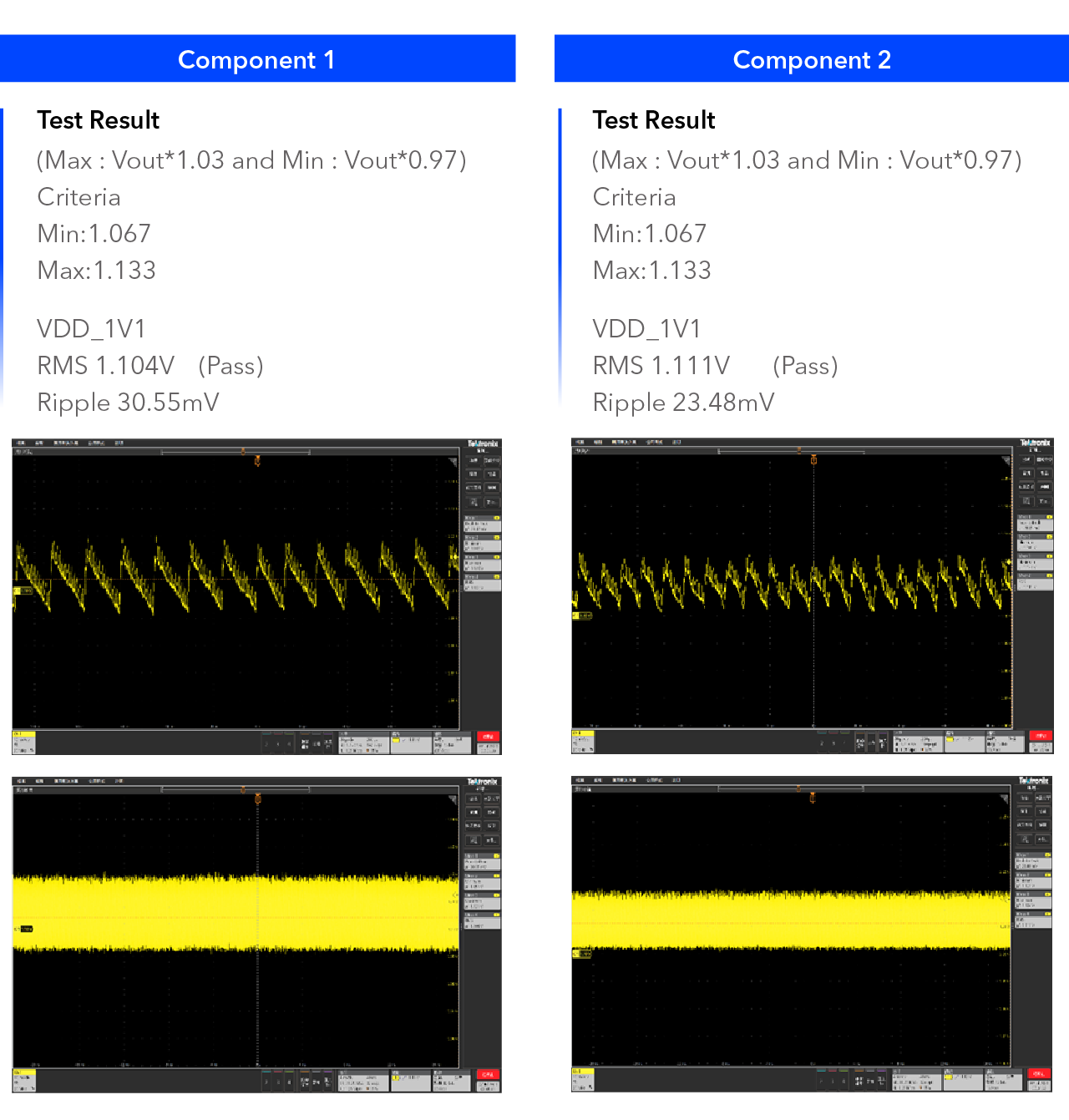
SPD Hub SI Testing for Reliable System Operation
Maintaining Signal Integrity is crucial in high-speed data transmission, as interference from transmission lines, DRAM ICs, PCBs, and other factors can disrupt signals. To ensure accurate data transmission, we perform SI testing using an oscilloscope to measure I2C/I3C signals from the SPD Hub. Testing, as shown below, revealed that Component B occasionally delivers lower amplitude signals, which can lead to data inconsistencies.
In contrast, Component A maintains consistent timing and amplitude characteristics, which are essential for reliable data transmission and system operation. This stability enhances overall system reliability. Therefore, using components that ensure stable signal integrity is vital for the smooth operation of memory modules in high-speed data environments.
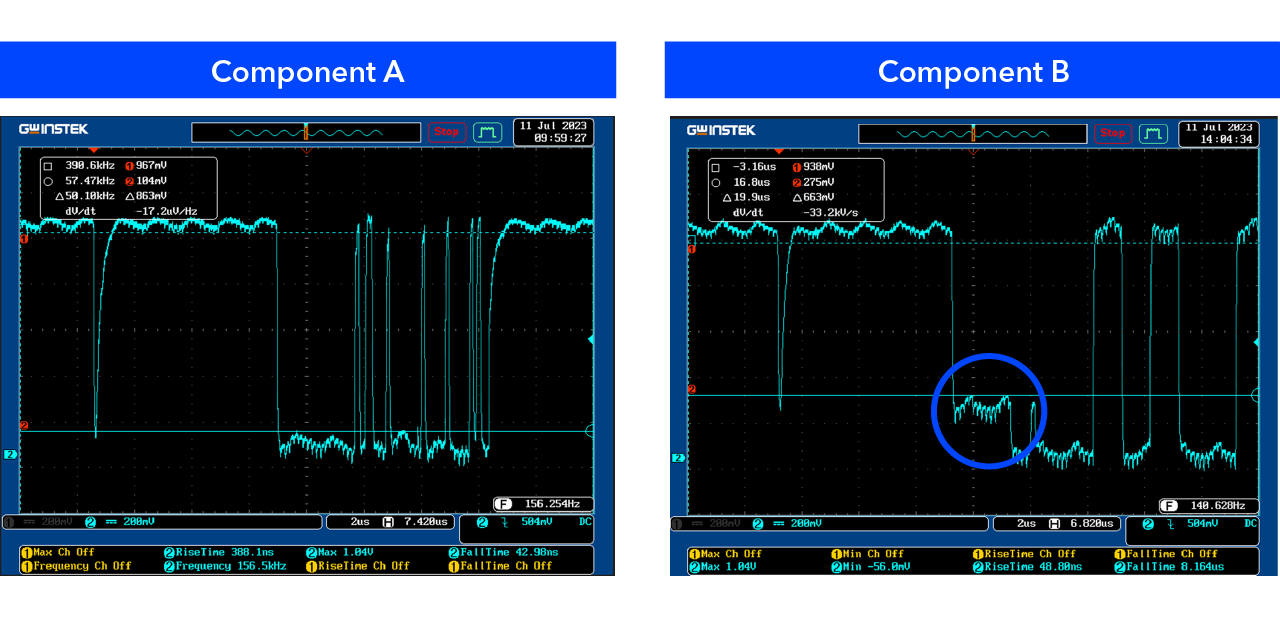
RMT Testing for Verifying Memory Compatibility
Intel RMT (Rank Margin Test) Testing is a standard test used to assess the signal quality between memory and the motherboard to determine compatibility. It focuses on the maximum tolerance range values for module timing and voltage.
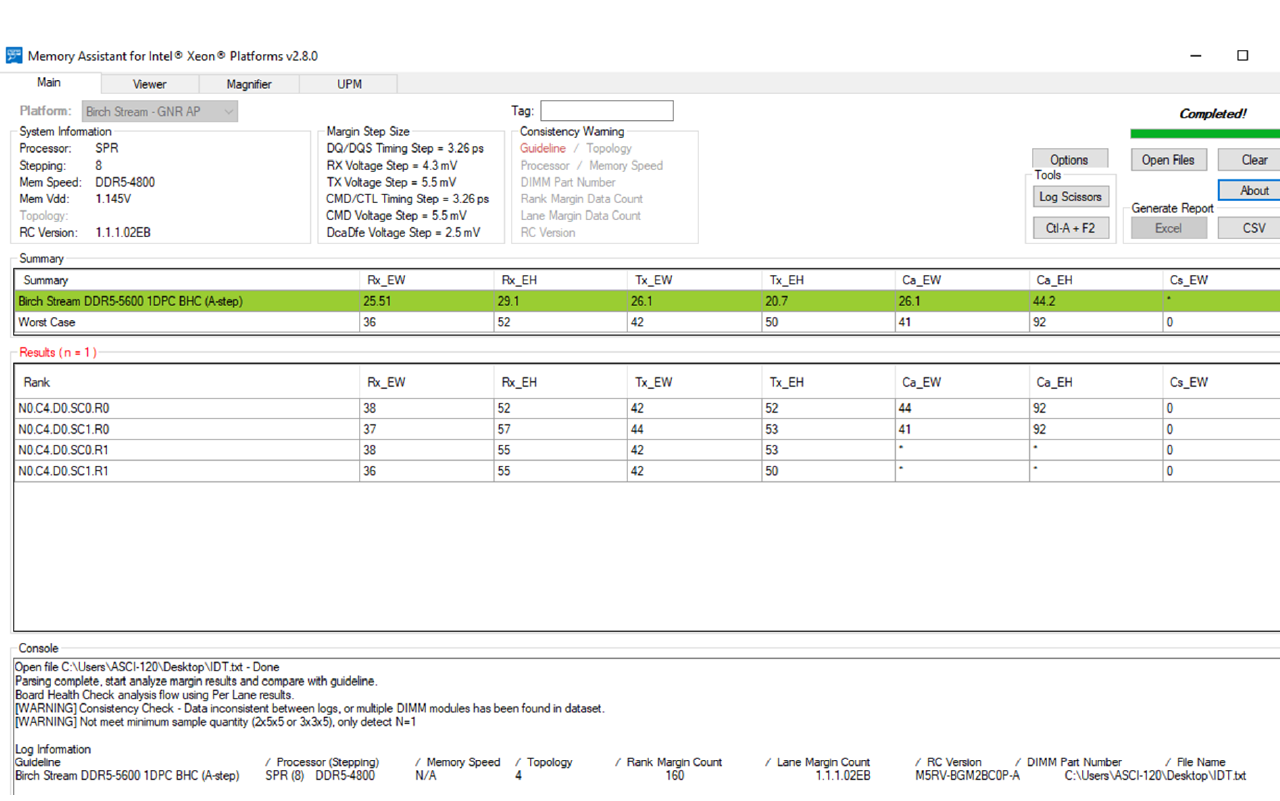
Impact of Component Placement on Signal Inference
Beyond examining individual component signals, we found that the arrangement of components and the type of PCB material can impact signal stability. The RDIMM VLP's PCB area is 40% smaller, resulting in closer component placement. This proximity can worsen signal interference, potentially destabilizing the signals.
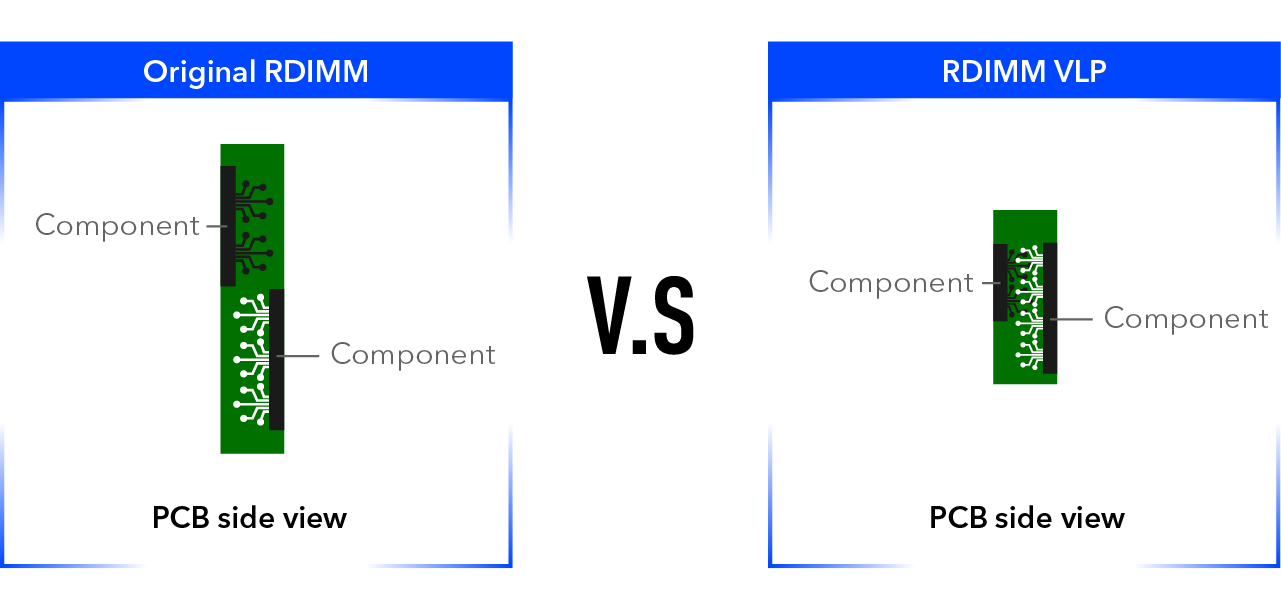
The Change of PCB Design
To minimize signal interference, we implemented two strategies: changing the wiring method and using PCB boards with more layers. The increased layer count in the PCB reduces the dielectric constant (DK), enhancing signal quality. Our RDIMM VLP product employs high-density interconnect (HDI) PCB manufacturing, which maximizes isolation and mitigates signal interference.
By subjecting our DDR5 RDIMM VLP modules to comprehensive testing procedures, we are able to identify and rectify any potential issues, thereby ensuring the highest level of quality and performance for our customers.
Conclusion
DDR5 RDIMM VLP modules offer an innovative solution for overcoming space limitations in server setups. With their smaller size and improved heat management, these modules allow organizations to maximize memory capacity without sacrificing performance or reliability. We ensure the stability of every component combination through rigorous testing, guaranteeing optimal performance for our customers. As businesses seek greater efficiency and scalability in their server setups, DDR5 RDIMM VLP modules provide a compelling option. They optimize space-constrained configurations, opening up new opportunities for efficiency and scalability in data centers.

